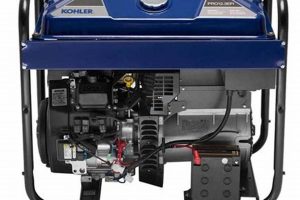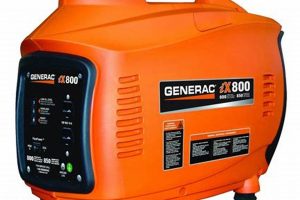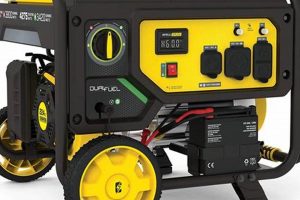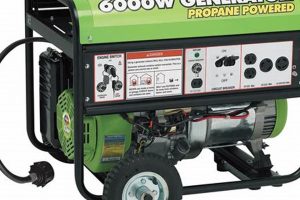Selecting the correct fuel source capacity for a portable generator involves considering the generator’s fuel consumption rate and desired runtime. A larger capacity provides longer operation without refueling, while a smaller tank offers increased portability. For example, a 20-pound propane tank might power a small generator for several hours, whereas a larger generator or longer runtime might necessitate a 40-pound or even a 100-pound tank. Careful matching of fuel supply to generator requirements ensures optimal performance and avoids interruptions.
Proper fuel capacity planning is essential for maximizing a portable generator’s utility. Choosing an appropriately sized tank ensures sufficient power for the intended duration, whether for recreational activities, emergency home backup, or job site power. Historically, generator users have relied on gasoline, but propane’s cleaner burning properties and longer shelf life have made it an increasingly popular alternative, expanding the range of suitable tank sizes available to consumers.
The following sections will explore the nuances of propane tank sizing for portable generators in greater detail. Factors such as generator power output, runtime expectations, and portability needs will be examined to provide a comprehensive understanding of fuel selection and management.
Tips for Selecting Appropriate Propane Tank Sizes for Portable Generators
Proper fuel tank selection is crucial for ensuring optimal generator performance and meeting power needs. The following tips offer guidance on choosing the correct propane tank size for a portable generator.
Tip 1: Review Generator Specifications: Consult the manufacturer’s documentation for the generator’s fuel consumption rate, typically measured in pounds per hour or gallons per hour. This information is essential for accurate tank sizing.
Tip 2: Determine Desired Runtime: Establish the required operational duration for the generator on a single tank. Longer runtimes necessitate larger tanks.
Tip 3: Calculate Propane Requirements: Multiply the generator’s fuel consumption rate by the desired runtime to determine the necessary propane capacity. Add a safety margin to account for unexpected variations in fuel consumption.
Tip 4: Consider Tank Portability: Larger tanks offer extended runtimes but can be less portable. Evaluate the trade-off between runtime and ease of transport based on the intended application.
Tip 5: Factor in Ambient Temperature: Propane vapor pressure can fluctuate with temperature, potentially impacting generator performance. Consult propane supplier guidelines for cold weather operation.
Tip 6: Inspect Tank Condition Regularly: Regularly inspect propane tanks for leaks, rust, or damage. Ensure proper valve function and adherence to safety regulations.
Tip 7: Explore Propane Tank Options: Research different propane tank types, such as vertical and horizontal tanks, to determine the optimal configuration for the specific generator and application.
By following these tips, users can ensure reliable generator operation with an appropriately sized propane tank, maximizing efficiency and minimizing disruptions.
This information provides a solid foundation for making informed decisions regarding propane tank selection for portable generators. The concluding section will reiterate key takeaways and offer additional resources for further exploration.
1. Generator Size
Generator size plays a critical role in determining the appropriate propane tank size. Larger generators generally consume more fuel per hour, necessitating larger tanks for comparable runtimes. Understanding the relationship between generator size and fuel consumption is essential for selecting a propane tank that meets specific power requirements.
- Power Output (Watts/Kilowatts):
Generators are categorized by their power output, typically measured in watts or kilowatts. A higher power output generally corresponds to a higher fuel consumption rate. For example, a 5,000-watt generator will consume propane more quickly than a 2,000-watt generator, requiring a larger tank for the same runtime.
- Fuel Consumption Rate (lbs/hr or gallons/hr):
Manufacturers specify a generator’s fuel consumption rate, indicating how much propane it uses per hour. This rate, often expressed in pounds per hour or gallons per hour, directly influences the required tank size. Comparing the fuel consumption rates of different generator sizes helps clarify their propane demands.
- Runtime Requirements:
The desired runtime significantly impacts the necessary tank size. Longer runtimes, regardless of generator size, demand larger propane reserves. For instance, running a small generator for eight hours requires a proportionally smaller tank than running a larger generator for the same duration, despite the lower power output.
- Tank Capacity (lbs or gallons):
Propane tanks are available in various capacities, measured in pounds or gallons. Matching the tank capacity to the generator size and desired runtime is crucial. A larger generator intended for extended use will necessitate a substantially larger tank than a smaller generator for short-term applications.
The interplay between these factors dictates the appropriate propane tank size for a portable generator. Careful consideration of power output, fuel consumption, and runtime requirements ensures efficient operation and prevents premature fuel depletion. Ultimately, selecting the correct tank size ensures the generator can deliver the necessary power for the intended duration.
2. Runtime Needs
Runtime needs directly influence propane tank sizing for portable generators. The desired duration of generator operation dictates the necessary fuel capacity. A longer required runtime necessitates a larger propane tank to sustain the generator’s fuel consumption. Calculating required runtime involves considering the specific application and anticipated power demands. For example, a short-term power outage for a residential setting might require a few hours of runtime, while extended camping trips or construction projects might necessitate significantly longer generator operation, influencing propane tank size selection. The relationship between runtime needs and tank size is crucial for ensuring sufficient fuel reserves.
Practical applications highlight the importance of accurately assessing runtime needs. Consider a scenario requiring a generator to power essential appliances during a power outage. Determining the average duration of such outages in the specific region informs the necessary generator runtime and, consequently, the appropriate propane tank size. For instance, if average outages last 8 hours, a propane tank capable of sustaining the generator for at least that duration becomes essential. Overestimating runtime needs leads to unnecessarily large, cumbersome tanks, while underestimating can result in premature fuel depletion and power loss. Real-life examples emphasize the practical implications of accurately determining runtime requirements.
Careful consideration of runtime needs ensures sufficient power for the intended duration. This understanding simplifies propane tank selection, balancing portability with required capacity. Failure to adequately assess runtime requirements can lead to operational disruptions and power shortages, highlighting the practical significance of this connection. Ultimately, the required runtime forms the basis for selecting the correct propane tank size, ensuring reliable generator operation when needed.
3. Fuel Consumption Rate
Fuel consumption rate represents a critical factor in determining the appropriate propane tank size for a portable generator. This rate, typically expressed in pounds per hour (lbs/hr) or gallons per hour (gal/hr), directly dictates how quickly a generator depletes its fuel source. Understanding this consumption rate is paramount for ensuring uninterrupted power supply for the desired duration.
- Generator Size and Load:
Larger generators, particularly when operating under heavy loads, exhibit higher fuel consumption rates. For instance, a 5,000-watt generator powering multiple appliances will consume propane more rapidly than a 2,000-watt generator running a single refrigerator. Matching the tank size to the anticipated load and generator size is essential.
- Efficiency and Engine Design:
Generator engine efficiency significantly influences fuel consumption. More efficient engines consume less fuel for the same power output, allowing for smaller tanks or extended runtimes. Conversely, less efficient engines require larger tanks to maintain operation for comparable periods. Researching generator specifications and comparing efficiency ratings can inform tank selection.
- Runtime Calculations:
Determining the required runtime is crucial for selecting the appropriate tank size. Multiplying the generator’s fuel consumption rate by the desired runtime yields the total fuel required. For example, a generator consuming 1 lb/hr of propane and requiring 10 hours of runtime necessitates a minimum of 10 pounds of propane. Adding a safety margin ensures sufficient fuel reserves.
- Propane Tank Capacity and Refill Frequency:
Available propane tank sizes range from smaller, portable tanks to larger, stationary options. Balancing tank capacity with refill frequency is essential. Larger tanks reduce refill frequency but compromise portability. Smaller tanks offer increased portability but necessitate more frequent refills, particularly for generators with high consumption rates.
Careful consideration of fuel consumption rate, alongside generator size, runtime requirements, and tank capacity, ensures an uninterrupted power supply. Accurate calculations based on these factors prevent premature fuel depletion, maximizing the generator’s utility and reliability.
4. Propane Tank Capacity
Propane tank capacity represents a pivotal factor in determining the appropriate propane tank size for a portable generator. The tank must hold sufficient propane to power the generator for the desired duration. Understanding the relationship between tank capacity and generator runtime is essential for selecting a tank that aligns with specific power requirements. Various tank sizes exist, each suited to different generator sizes and runtime needs.
- Tank Size and Runtime:
Tank size directly correlates with potential generator runtime. Larger tanks hold more propane, enabling longer operation without refueling. A 20-pound tank might suffice for a small generator powering essential appliances for a few hours, while a 100-pound tank could sustain a larger generator for considerably longer, particularly under lighter loads. Matching tank size to anticipated runtime is crucial.
- Generator Fuel Consumption:
The generator’s fuel consumption rate dictates how quickly it depletes the propane supply. A higher consumption rate necessitates a larger tank for the same runtime. For example, a generator consuming 2 pounds of propane per hour requires a 20-pound tank for a 10-hour runtime. Careful consideration of fuel consumption and tank capacity ensures uninterrupted power.
- Portability and Practicality:
Tank size influences portability. While larger tanks provide extended runtimes, they are heavier and less maneuverable. Smaller tanks enhance portability but require more frequent refills, particularly for generators with high fuel consumption rates. Balancing capacity with portability depends on the intended application, whether for recreational activities, job site power, or emergency home backup.
- Safety Considerations and Regulations:
Propane tank safety is paramount. Larger tanks present greater hazards in case of leaks or accidents. Adherence to local regulations regarding propane storage and handling is essential, regardless of tank size. Regular tank inspections for leaks, damage, and proper valve function are crucial for safe operation.
Selecting the appropriate propane tank capacity involves balancing runtime requirements, generator fuel consumption, portability needs, and safety considerations. A careful assessment of these factors ensures reliable generator operation for the desired duration, maximizing efficiency and safety.
5. Portability Requirements
Portability requirements significantly influence propane tank selection for portable generators. The intended use case dictates the balance between a longer runtime provided by larger tanks and the ease of transport afforded by smaller tanks. Careful consideration of portability needs ensures the selected tank complements the generator’s mobility and intended applications.
- Weight and Maneuverability:
Larger propane tanks, while offering extended runtimes, are inherently heavier and less maneuverable. This can pose challenges in applications requiring frequent relocation of the generator, such as camping, tailgating, or job site use. Smaller tanks, conversely, sacrifice runtime for increased portability, simplifying transport and setup. The weight and maneuverability of the chosen tank must align with the anticipated movement and handling requirements.
- Storage and Transportation:
Storage and transportation logistics further impact tank selection. Larger tanks require more storage space and specialized transport mechanisms, while smaller tanks readily fit within confined spaces and are easier to transport in standard vehicles. Consider the available storage space and typical transportation methods when selecting a tank size to ensure practical handling and storage solutions.
- Application-Specific Needs:
The specific application dictates the prioritization of runtime versus portability. Emergency home backup power might favor larger tanks for extended operation, while recreational activities like camping might prioritize smaller, more portable tanks. Job site applications often present a compromise, balancing runtime needs with the practicality of transporting the tank within the work environment. Tailoring tank size to the intended use optimizes the generator’s overall utility.
- Accessibility and Terrain:
The accessibility of the generator’s operating location and the surrounding terrain further influence tank selection. Remote locations or challenging terrain necessitate careful consideration of tank size and weight for practical transport and maneuverability. Smaller, lighter tanks often prove advantageous in such scenarios, even at the expense of runtime, to ensure the generator can be positioned effectively.
Balancing portability requirements with desired runtime involves careful evaluation of weight, maneuverability, storage constraints, and application-specific needs. Selecting a propane tank that aligns with these considerations ensures the generator remains both portable and capable of delivering the necessary power for the intended duration and location.
6. Safety Regulations
Safety regulations governing propane tank usage are paramount when selecting a tank for a portable generator. These regulations ensure safe handling, storage, and operation, mitigating potential hazards associated with propane, a flammable gas. Compliance with these regulations is not only essential for personal safety but also often legally mandated. Understanding and adhering to these guidelines is crucial for responsible generator operation.
- Ventilation Requirements:
Adequate ventilation is essential to prevent propane accumulation, which can lead to explosions or asphyxiation. Safety regulations mandate specific ventilation requirements for propane tank storage and generator operation. These regulations stipulate minimum clearances from buildings, ignition sources, and other flammable materials. Proper ventilation ensures safe dispersal of any leaking propane, minimizing potential hazards.
- Tank Placement and Security:
Safety regulations dictate proper placement and security of propane tanks to prevent accidental damage or tampering. Tanks must be secured upright on a stable surface, away from high-traffic areas and potential impact hazards. Regulations often specify approved methods for securing tanks, such as straps or chains, to prevent tipping or rolling. Proper placement and security minimize the risk of leaks and subsequent fires or explosions.
- Connection and Leak Testing:
Secure and leak-free connections between the propane tank and the generator are critical. Safety regulations outline approved connection methods and materials, ensuring proper sealing and preventing leaks. Regular leak testing, using soapy water or a specialized leak detector, is essential to identify and address potential leaks promptly. Proper connection and leak testing procedures minimize the risk of uncontrolled propane release.
- Transportation and Storage Regulations:
Transporting and storing propane tanks safely requires adherence to specific regulations. These regulations often restrict tank placement within vehicles and mandate proper ventilation during transport. Storage regulations address proper tank orientation, temperature limits, and proximity to flammable materials. Adhering to these regulations minimizes the risks associated with propane transport and storage, protecting both individuals and property.
Adherence to safety regulations is integral to responsible propane tank usage with portable generators. These regulations, encompassing ventilation, placement, connection, and transportation considerations, minimize potential hazards associated with propane handling and ensure safe generator operation. Compliance safeguards individuals and property while maximizing the generator’s utility within established safety parameters.
7. Ambient Temperature
Ambient temperature significantly influences propane performance and consequently impacts portable generator operation. Propane, stored as a liquid within the tank, vaporizes to a gaseous state for combustion within the generator. Temperature fluctuations directly affect this vaporization process. Lower temperatures reduce propane vapor pressure, potentially hindering the generator’s ability to draw sufficient fuel for optimal performance. Conversely, higher temperatures increase vapor pressure, potentially exceeding safe operating limits. Understanding this temperature dependency is crucial for selecting an appropriately sized propane tank and ensuring reliable generator operation across varying environmental conditions.
Practical implications of temperature’s influence on propane performance manifest in various real-world scenarios. During cold weather operation, reduced vapor pressure can lead to insufficient fuel supply, causing the generator to stall or operate at reduced power. This poses significant challenges for applications reliant on consistent power, such as heating systems during winter outages. Conversely, excessively high temperatures can create unsafe pressure levels within the tank, increasing the risk of leaks or equipment malfunction. Consider a construction site operating a generator during a heatwave; high ambient temperatures can exacerbate propane expansion, stressing tank components and potentially compromising safety. These examples underscore the practical significance of accounting for ambient temperature when sizing and utilizing propane tanks for portable generators.
Addressing temperature-related challenges necessitates proactive measures. Insulating propane tanks or utilizing tank heaters during cold weather can mitigate reduced vapor pressure issues, ensuring consistent fuel delivery to the generator. Conversely, operating generators in shaded areas during high temperatures helps manage propane pressure within safe limits. Furthermore, understanding the temperature limitations of specific propane tank and generator models is essential for safe and efficient operation. Ultimately, recognizing the interplay between ambient temperature and propane performance is critical for selecting the correct tank size, implementing appropriate operational strategies, and ensuring reliable generator performance across diverse environmental conditions.
Frequently Asked Questions
This section addresses common inquiries regarding propane tank sizing for portable generators, providing concise and informative responses to facilitate informed decision-making.
Question 1: How long will a 20-pound propane tank power a portable generator?
Runtime depends on the generator’s size and fuel consumption rate. A 20-pound tank might power a small generator (around 2,000 watts) for 8-10 hours at half load, while a larger generator will consume the fuel more quickly.
Question 2: Can any size propane tank be used with any portable generator?
Generators are designed for specific propane tank sizes and pressures. Consult the generator’s documentation to determine compatible tank sizes. Using an incorrect tank size can compromise performance or pose safety risks.
Question 3: What are the advantages of using propane over gasoline for a portable generator?
Propane offers a longer shelf life than gasoline, deteriorating less over time. It also burns cleaner, producing fewer emissions. However, propane requires specific tanks and connections, while gasoline can be readily available.
Question 4: How is propane consumption affected by generator load?
Higher loads increase propane consumption. Running a generator at full capacity will deplete the propane tank significantly faster than operating under a lighter load. Understanding the generator’s power requirements for intended applications is crucial for accurate tank sizing.
Question 5: Are there safety considerations specific to using propane with portable generators?
Propane requires specific safety precautions. Proper ventilation is essential to prevent gas accumulation. Tanks should be stored and handled according to safety regulations. Regularly inspect connections and tanks for leaks.
Question 6: How does cold weather affect propane usage with portable generators?
Cold temperatures can reduce propane vapor pressure, potentially hindering generator performance. Tank heaters or insulated covers can mitigate this issue, ensuring consistent fuel delivery in cold climates.
Careful consideration of these frequently asked questions, combined with the information presented earlier, enables well-informed decisions regarding propane tank selection and safe, efficient generator operation.
This concludes the discussion on propane tank sizing for portable generators. Consult manufacturer guidelines and safety regulations for detailed instructions and recommendations relevant to specific generator and tank models.
What Size Propane Tank for Portable Generator
Determining the appropriate propane tank size for a portable generator requires careful consideration of interconnected factors. Generator size and anticipated load directly influence fuel consumption rates, dictating the necessary tank capacity for desired runtimes. Portability requirements further refine tank selection, balancing extended operation with ease of transport and storage. Ambient temperature considerations, particularly in extreme climates, necessitate adjustments to ensure reliable fuel delivery and prevent safety hazards. Adherence to safety regulations governing propane handling, storage, and ventilation is paramount for mitigating risks associated with flammable gas usage. Ultimately, a comprehensive understanding of these factors ensures efficient, safe, and reliable generator operation, providing uninterrupted power for various applications.
Informed selection of a propane tank empowers users to maximize their portable generator’s utility while adhering to safety best practices. Careful planning and consideration of operational needs ensure sufficient power for intended applications, from emergency home backup to recreational activities and job site support. Continued adherence to evolving safety standards and best practices remains essential for responsible and effective generator usage. Appropriate tank sizing, coupled with informed operation, unlocks the full potential of portable generators as reliable power sources in diverse contexts.






